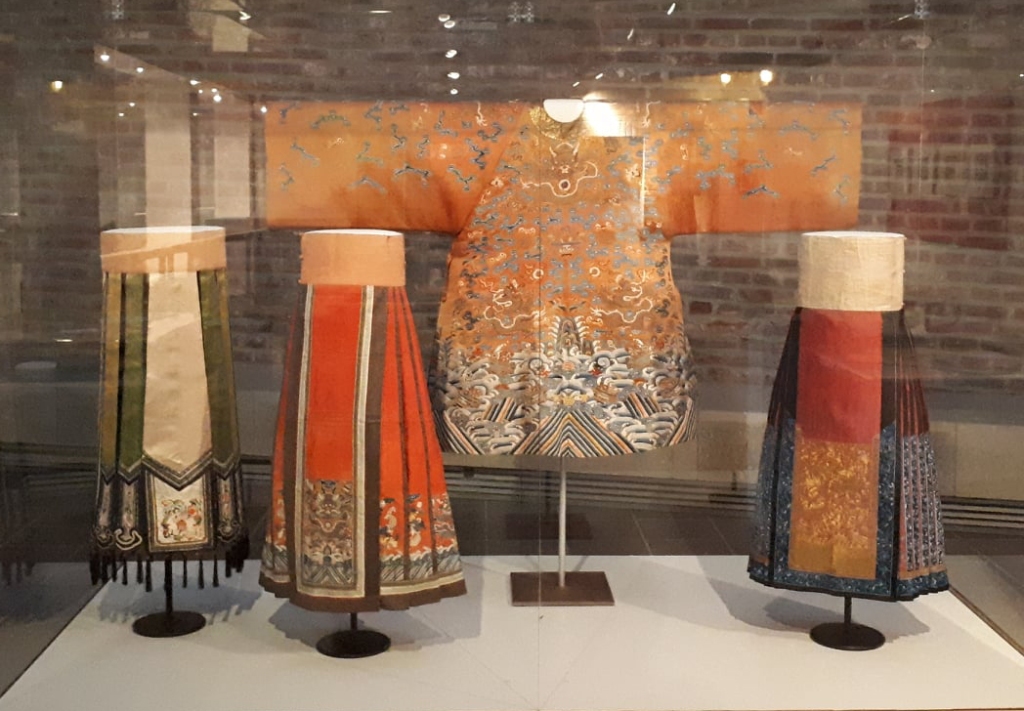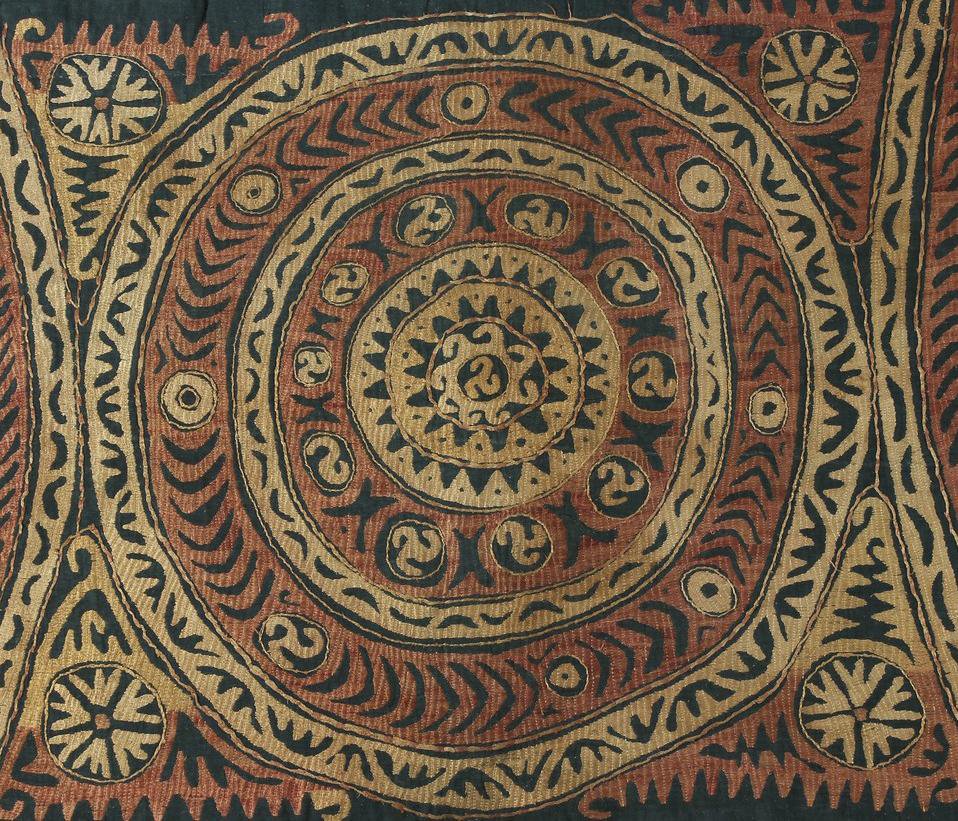
The exhibition Drachen aus goldenen Fäden – Dragons from Golden Threads is reopening on 16 March at the German Textile Museum in Krefeld and will run until September 2021.

This exhibition of around 120 pieces has been curated by Walter Bruno Brix, and contains textiles from the Yuan Dynasty (1279–1368) to the People’s Republic of China (1949). “Special objects include fragments of an imperial robe from the eighteenth century, a robe with dragon medallions for a noble lady in slit tapestry, two oversized robes for statues of gods, an imperial shroud, a large fragment of a palace carpet made of silk velvet”- museum website.

More information on some of the extraordinary pieces, as well as additional images, can be found in this article by Petra Diederichs for RP Online. An 18 minute video of the exhibition has also been produced. Even if you don’t speak German it is well worth watching as it is a visual treat!

In my most recent blog I shared a link to an online exhibition of socks from the collection of the Bata Shoe Museum, Toronto. A reminder that next Saturday, 20 March, the Textile Museum will host an online talk as part of its Rug and Textile Appreciation series. The subject will be Embroidered Shoes from the Bata Shoe Museum, 1700-1950. Edward Maeder, who has been a museum curator and director since 1977, ” will explore examples from the world of European high fashion, including remarkable shoes from the eighteenth and nineteenth centuries. Maeder will also discuss shoes made with ethnographically specific decorative textile techniques, such as Persian ‘rasht-work’. This type of inlayed wool-work is extensively finished with silk chain-stitch embroidery. Other complex embroidery methods incorporate glass beads, moose-hair and fine gold and silver embroidery on leather, silk and even wool.” – Textile Museum. This free talk will begin at 11:00 EDT, which is 15:00 GMT. Click here to register.

As a complete contrast to the embroidered shoes shown above, I was struck by the simple elegance of these woven wicker shoes from the collection of Kent State University Museum. They are Chinese and were made in the twentieth century. The craftsmanship is superb!

A new exhibition opened yesterday at the Russian Ethnographic Museum (REM). This exhibition is entitled Avant-garde? Dagestan Tradition! Kaitag embroidery from the collection of the REM and features a selection of embroideries from the eighteenth and early nineteenth centuries. “The embroidery owes its name to the ethnographer E.M. Shilling, who in the middle of the twentieth century first described small canvases with a peculiar decor, found by him among the Kaitags (subethnos of the Dargins) in the Kaitag region of Dagestan.” – REM website. More information and excellent detailed images of some of the exhibits is available here.

Next Saturday, 20 March (a very busy day for events as regular readers will know) the Bowers Museum in California will host an online talk by Victoria Lautman on the subject of stepwells. These are magnificent subterranean water-harvesting structures found in India for many centuries. “Victoria Lautman has spent years documenting hundreds of the little-known underground edifices and her landmark book, The Vanishing Stepwells of India, was first published in 2017 (Merrell Publishers, London). Newly released in paperback, the book and Victoria’s lavishly illustrated talk trace the fascinating history, variety, and current state of India’s least-known marvels.” – Bowers website. The talk takes place at 13:30 PDT, which is 16:30 in the UK. Click here for more details and talk registration.

Cotton and silk plain weave (strip woven) with cotton embroidery. ©Rhode Island School of Design Museum
The Rhode Island School of Design Museum currently has an interesting exhibition called It Comes in Many Forms: Islamic Art from the Collection. This “presents textiles, decorative arts, and works on paper that attest to the pluralism of Islam and its expressions. From an Egyptian textile fragment dating to the 1100s to a contemporary woman’s top by the Paris-based designer Azzedine Alaïa, 30 objects offer explorations into migration, diasporas, and exchange and suggest the difficulty of defining arts from a transnational religious viewpoint.” – RISD website. This exhibition runs until 14 August 2021.
A reminder of the other talks taking place next weekend:

On Saturday 20 March at 10:00 PDT, which is 17:00 in the UK, the Textile Arts Council will host Carol Cassidy who will talk on the subject of Weaving, Tradition, Art and Community. Carol founded Lao Textiles in Vientiane in 1990. It was the first American business in the country and was based on the traditional skills of the weavers. There is a small fee for non-members and you can register here.

Also on 20 March the OATG is delighted to be welcoming back Dr. Geneviève Duggan to give another talk. Dr. Duggan is an anthropologist who has researched the culture, history and weaving traditions of the remote Indonesian island of Savu for three decades. The intriguing title of the talk is People without history in eastern Indonesia, powerful or powerless? Dr. Duggan will discuss several important life cycle ceremonies, which are the responsibility of women “whose intangible power resides in handwoven cloths produced for the occasion”. The talk will begin at 11:00 am GMT. Unfortunately this timing doesn’t work well for our members on the West coast of the USA, but as Geneviève is based in Singapore we were restricted in our choice. The recording of the programme will later be archived in the members-only section of our website. This event is of course free for OATG members. Non-members are welcome for a small fee, but do need to register by clicking here – don’t forget places are limited! Having visited the weavers on Savu many times, including several times with Geneviève, I can thoroughly recommend this talk.
Finally, copies of the next edition of Asian Textiles should be arriving with members any day now – ours arrived yesterday. It’s always a treat to make a cuppa and see what delights are inside its covers. If you have any ideas for future editions of the journal or the Lockdown Newsletter please contact our editor Gavin Strachan.